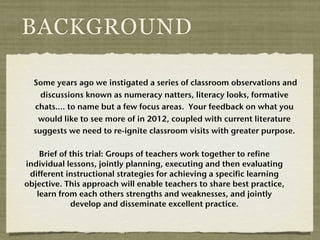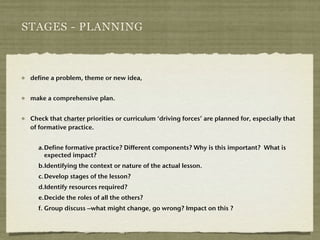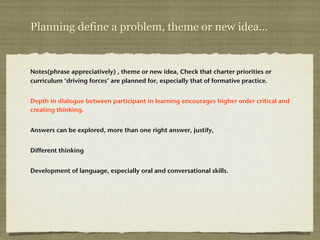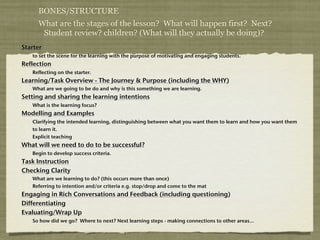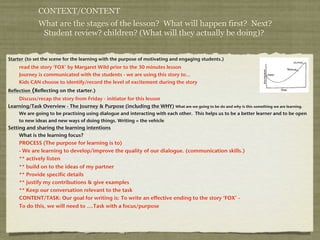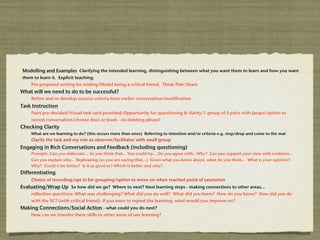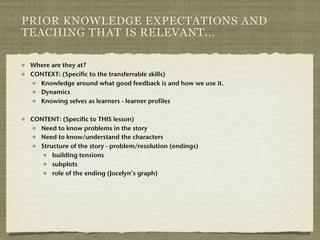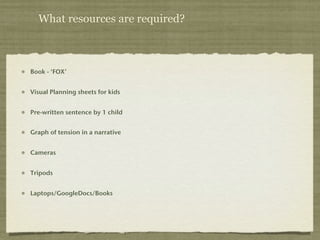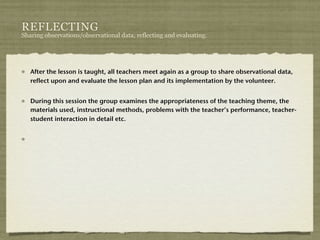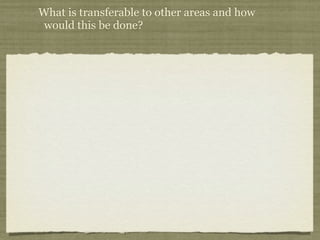Jugyou kenyyuu (1)
- 1. JUGYOU KENYYUU Teacher Inquiry RSS Style
- 2. BACKGROUND Some years ago we instigated a series of classroom observations and discussions known as numeracy natters, literacy looks, formative chats…. to name but a few focus areas. Your feedback on what you would like to see more of in 2012, coupled with current literature suggests we need to re-ignite classroom visits with greater purpose. Brief of this trial: Groups of teachers work together to refine individual lessons, jointly planning, executing and then evaluating different instructional strategies for achieving a specific learning objective. This approach will enable teachers to share best practice, learn from each others strengths and weaknesses, and jointly develop and disseminate excellent practice.
- 3. STAGES - PLANNING define a problem, theme or new idea, make a comprehensive plan. Check that charter priorities or curriculum ‘driving forces’ are planned for, especially that of formative practice. a.! efine formative practice? Different components? Why is this important? What is D expected impact? b.Identifying the context or nature of the actual lesson. c.!Develop stages of the lesson? d.Identify resources required? e.! ecide the roles of all the others? D f.!Group discuss –what might change, go wrong? Impact on this ?
- 4. Planning define a problem, theme or new idea... Notes(phrase appreciatively) , theme or new idea, Check that charter priorities or curriculum ‘driving forces’ are planned for, especially that of formative practice. Depth in dialogue between participant in learning encourages higher order critical and creating thinking. Answers can be explored, more than one right answer, justify, Different thinking Development of language, especially oral and conversational skills.
- 5. What is meant by formative practice? Different components? Why is this important? What is expected impact? Student Teacher • Co-construction of learning • Knowing the learner intentions and success criteria. • moving children from where they are. • Understanding the learning as • Differentiated opposed to the activity/ • Unlocking prior knowledge context. • Engaging rich purposeful learning • Dialogue focus on the learning. • Rich questioning • Increasing self awareness • Setting and sharing learning intentions. • Peer and self assessment • Unpacking the learning. • Acting on or responding to • Effective Feedback feedback. • Providing the time and structure, model. • Ongoing goal setting - • Monitoring progress - authentic awareness of progress and next assessment learning steps • Analysing assessment • Choices
- 6. Identifying the context or nature of the actual lesson. (What is going to be taught….content). Is this going to be whole class or small group? Collaborative writing Focus - giving & receiving feedback/quality dialogue Small group Wanting to develop the depth and quality of writing Acting on feedback Recognising what they need to do to get better - using the criteria Peer and self-evaluation Time
- 7. BONES/STRUCTURE What are the stages of the lesson? What will happen first? Next? Student review? children? (What will they actually be doing)? Starter to set the scene for the learning with the purpose of motivating and engaging students. Reflection Reflecting on the starter. Learning/Task Overview - The Journey & Purpose (including the WHY) What are we going to be do and why is this something we are learning. Setting and sharing the learning intentions What is the learning focus? Modelling and Examples Clarifying the intended learning, distinguishing between what you want them to learn and how you want them to learn it. Explicit teaching What will we need to do to be successful? Begin to develop success criteria. Task Instruction Checking Clarity What are we learning to do? (this occurs more than once) Referring to intention and/or criteria e.g. stop/drop and come to the mat Engaging in Rich Conversations and Feedback (including questioning) Differentiating Evaluating/Wrap Up So how did we go? Where to next? Next learning steps - making connections to other areas...
- 8. CONTEXT/CONTENT What are the stages of the lesson? What will happen first? Next? Student review? children? (What will they actually be doing)? Starter (to set the scene for the learning with the purpose of motivating and engaging students.) read the story ‘FOX’ by Margaret Wild prior to the 30 minutes lesson Journey is communicated with the students - we are using this story to... Kids CAN choose to identify/record the level of excitement during the story Reflection (Reflecting on the starter.) Discuss/recap the story from Friday - initiator for this lesson Learning/Task Overview - The Journey & Purpose (including the WHY) What are we going to be do and why is this something we are learning. We are going to be practising using dialogue and interacting with each other. This helps us to be a better learner and to be open to new ideas and new ways of doing things. Writing = the vehicle Setting and sharing the learning intentions What is the learning focus? PROCESS (The purpose for learning is to) - We are learning to develop/improve the quality of our dialogue. (communication skills.) ** actively listen ** build on to the ideas of my partner ** Provide specific details ** justify my contributions & give examples ** Keep our conversation relevant to the task CONTENT/TASK: Our goal for writing is: To write an effective ending to the story ‘FOX’ - To do this, we will need to ....Task with a focus/purpose
- 9. Modelling and Examples Clarifying the intended learning, distinguishing between what you want them to learn and how you want them to learn it. Explicit teaching. Pre-prepared writing for ending/Model being a critical friend. Think/Pair/Share What will we need to do to be successful? Refine and re-develop success criteria from earlier conversation/modification Task Instruction Pairs pre-decided/Visual task card provided/Opportunity for questioning & clarity/1 group of 3 pairs with Jacqui/option to record conversation/choose docs or book - no deleting please! Checking Clarity What are we learning to do? (this occurs more than once) Referring to intention and/or criteria e.g. stop/drop and come to the mat Clarify the task and my role as observer/facilitator with small group Engaging in Rich Conversations and Feedback (including questioning) Prompts: Can you elaborate... So you think that... You could try... Do you agree with.. Why? Can you support your view with evidence... Can you explain why... Rephrasing (so you are saying that...) Given what you know about, what do you think... What is your opinion? Why? Could it be better? Is it as good as? Which is better and why? Differentiating Choice of recording/opt in for grouping/option to move on when reached point of saturation Evaluating/Wrap Up So how did we go? Where to next? Next learning steps - making connections to other areas... reflection questions: What was challenging? What did you do well? What did you learn? How do you know? How did you do with the SC? (with critical friend) If you were to repeat the learning, what would you improve on? Making Connections/Social Action - what could you do next? How can we transfer these skills to other areas of our learning?
- 10. PRIOR KNOWLEDGE EXPECTATIONS AND TEACHING THAT IS RELEVANT... Where are they at? CONTEXT: (Specific to the transferrable skills) Knowledge around what good feedback is and how we use it. Dynamics Knowing selves as learners - learner profiles CONTENT: (Specific to THIS lesson) Need to know problems in the story Need to know/understand the characters Structure of the story - problem/resolution (endings) building tensions subplots role of the ending (Jocelyn’s graph)
- 11. What resources are required? Book - ‘FOX’ Visual Planning sheets for kids Pre-written sentence by 1 child Graph of tension in a narrative Cameras Tripods Laptops/GoogleDocs/Books
- 12. Structure of how the group will work –who is teaching? (work this out at the beginning) What are the roles of all the others? Teaching 1st Lesson: Jacqui Video: child James: Records Teacher lesson structure Ngaire: Recording/focusing on student dialogue and interaction Ebony: Recording/focusing on student dialogue and interaction Jocelyn: Recording Teacher Prompts Nicole:Rest of class
- 13. Group discuss –what might change, go wrong? Impact on this ? Get stuck on the written component of the learning rather than the dialogue (teacher/ student) Social issues - grouping and dynamics Depth is unable to be reached Pitched too high or too low Illness Overplanned??? Time
- 14. What’s Next? Implementing and Observing. Implementing the experimental lesson, replanning lessons, reintroducing the new version of the lesson plans. One of the teachers agreed to give a lesson based upon the lesson cooperatively devised with colleagues. Other teachers become active observers, taking notes. Each teacher has a specifically assigned role: these are possibilities -one videotapes, one examines the entire learning-teaching process, another focuses on classroom management, another the student-teacher interaction ….student-student interaction etc
- 15. REFLECTING Sharing observations/observational data, reflecting and evaluating. After the lesson is taught, all teachers meet again as a group to share observational data, reflect upon and evaluate the lesson plan and its implementation by the volunteer. During this session the group examines the appropriateness of the teaching theme, the materials used, instructional methods, problems with the teacher’s performance, teacher- student interaction in detail etc.
- 16. Clarify expectations of participants ----there must be a measured response…..balance the positives with negatives….
- 17. So how did it go? What went well? What features really came to the fore? What changed? Why? Was our intent met? To what degree did thr
- 18. What would we change for the next person to implement? Develop the next plan.
- 19. What is transferable to other areas and how would this be done?
- 20. Revising –Investigating new teaching strategies, revising the lessons, reporting & disseminating, devising a new version of the lesson plan.
Editor's Notes
- \n
- \n
- \n
- \n
- \n
- \n
- \n
- \n
- \n
- \n
- \n
- \n
- \n
- \n
- \n
- \n
- \n
- \n
- \n
- \n

